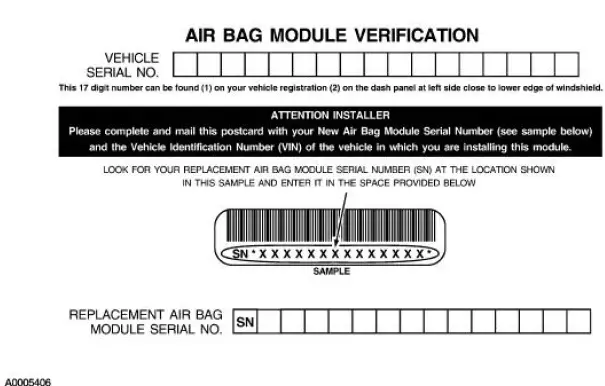Ford Mustang (1999-2004) Service Manual: Air Bag Disposal - Undeployed Inoperative
WARNING: Always wear safety glasses when repairing an air bag supplemental restraint system (SRS) vehicle and when handling an air bag module. This will reduce the risk of injury in the event of an accidental deployment.
WARNING: Never probe the connectors on the air bag module. Doing so can result in air bag deployment, which can result in personal injury.
WARNING: Carry a live air bag module with the air bag and trim cover or deployment door pointed away from your body. This will reduce the risk of injury in the event of an accidental deployment.
NOTE: All inoperative air bag modules and safety belt pretensioners have been placed on the Mandatory Return List. All discolored or damaged air bag modules must be treated the same as any inoperative live air bag being returned.
1. Remove the inoperative component from the vehicle. For additional information, refer to the appropriate air bag procedure in this section.

2. NOTE: When installing a new air bag module, a prepaid return postcard is provided with the replacement air bag module. The serial number for the new part and the vehicle identification number (VIN) must be recorded and sent to Ford Motor Company.
If installing a new air bag module, record the necessary information and return the inoperative air bag module to Ford Motor Company.
 Inspection and Repair After a Supplemental Restraint
System (SRS) Deployment
Inspection and Repair After a Supplemental Restraint
System (SRS) Deployment
WARNING: If the supplemental restraint system (SRS) is being serviced,
the system must
be deactivated and restraint system diagnostic tools must be installed. Refer to
Air Bag
Supplemental Restraint ...
 Air Bag Disposal - Driver, Undeployed, Scrapped
Vehicle
Air Bag Disposal - Driver, Undeployed, Scrapped
Vehicle
Remote Deployment
WARNING: Always wear safety glasses when repairing an air bag
supplemental restraint
system (SRS) vehicle and when handling an air bag module or safety belt
retractor/preten ...
Other materials:
Air Conditioning (A/C) Compressor - 3.8L
Material
Item
Specification
PAG Refrigerant Compressor
Oil (R-134a Systems)
F7AZ-19589-DA (Motorcraft YN-
12-C)
WSH-M1C231-
B
Removal and Installation
CAUTION: If installing a new air conditioning compressor due to an
internal failur ...
Removal
Convertible
1. For removal of the back window glass, refer to Section.
Coupe
WARNING: To prevent glass splinters from entering eyes or
cutting hands, wear safety
glasses and heavy gloves when cutting glass from the vehicle.
2. Remove the roof side ...
Positive Crankcase Ventilation (PCV) Hose
Removal and Installation
1. Disconnect the hose on the PCV valve.
2. Twist and remove the PCV valve.
3. To install, reverse the removal procedure.
...
